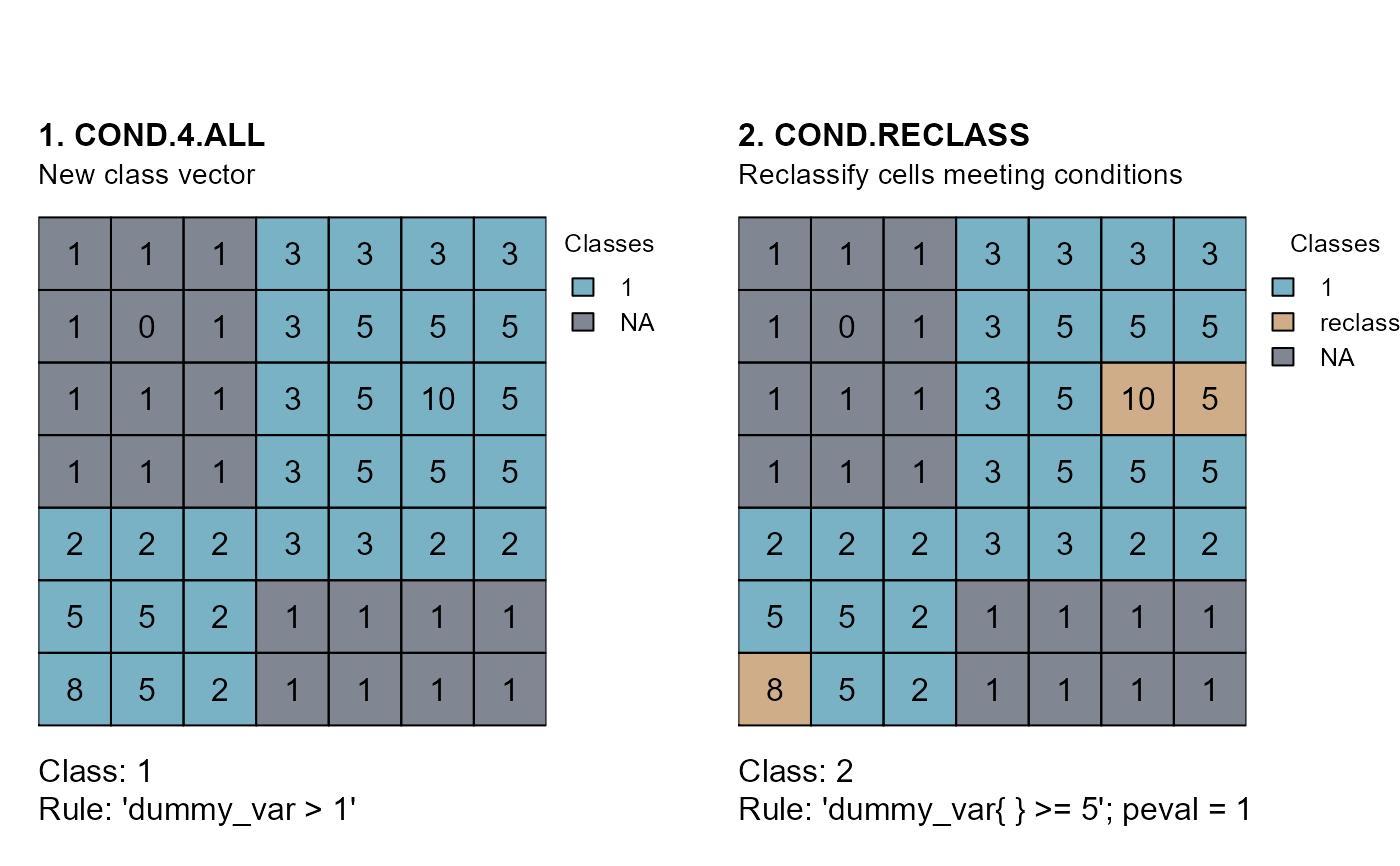Evaluate conditions for cells of a class and reclassify them if conditions are true.
cond.reclass(
attTbl,
ngbList = NULL,
rNumb = FALSE,
classVector,
class,
cond,
reclass,
peval = 1
)Arguments
- attTbl
data.frame, the attribute table returned by the function
attTbl.- ngbList
list, the list of neighborhoods returned by the function
ngbList. Only necessary if using an absolute neighborhood condition (seeconditions).- rNumb
logic, the neighborhoods of the argument
ngbListare identified by cell numbers (rNumb=FALSE) or by row numbers (rNumb=TRUE) (seengbList). It is advised to use row numbers for large rasters.- classVector
numeric vector, defines the cells in the attribute table that have already been classified. See
conditionsfor more information about class vectors.- class
numeric or numeric vector, indicates the class(es) for which conditions have to be evaluated.
- cond
character string, the conditions a cell have to meet to be classified as indicated by the argument
reclass. Seeconditionsfor more details.- reclass
numeric, the classification number to assign to all cells that meet the function conditions.
- peval
numeric value between 0 and 1. If absolute neighborhood conditions are considered, test cells are classified if the number of positive evaluations is equal or greater than the percentage specified by the argument
peval(seeconditions).
Value
Update classVector with the new cells that were classified by
the function. See conditions for more information about class
vectors.
Details
The function evaluates the conditions of the argument
condfor all cells in the classes of the argumentclass.Cells that meet the function conditions are re-classified as indicted by the argument
reclass.Absolute test cell and neighborhood conditions can be used. The condition string can only include one neighborhood condition (
'{}') (seeconditions).
See also
Examples
# DUMMY DATA
######################################################################################
library(scapesClassification)
library(terra)
# LOAD THE DUMMY RASTER
r <- list.files(system.file("extdata", package = "scapesClassification"),
pattern = "dummy_raster\\.tif", full.names = TRUE)
r <- terra::rast(r)
# COMPUTE THE ATTRIBUTE TABLE
at <- attTbl(r, "dummy_var")
# COMPUTE THE LIST OF NEIGBORHOODS
nbs <- ngbList(r)
################################################################################
# RECLASS.NBS
################################################################################
# Compute an example class vector
cv <- cond.4.all(attTbl = at, cond = "dummy_var > 1", class = 1)
# Reclassify cells
cr <- cond.reclass(attTbl = at, ngbList = nbs,
# CLASS VECTOR COMPUTED WITH THE RULE "dummy_var > 1"
classVector = cv,
# CELLS TO RECLASSIFY HAVE THIS CLASS
class = 1,
# ABSOLUTE NEIGHBORHOOD CONDITION
cond = "dummy_var{} >= 5", peval = 1,
# NEW CLASSIFICATION NUMBER
reclass = 2)
# Convert class vectors to rasters
r_cv <- cv.2.rast(r, cv)
r_cr <- cv.2.rast(r, cr)
################################################################################
# PLOTS
################################################################################
oldpar <- par(mfrow = c(1,2))
m <- c(3, 1, 5, 4)
# 1.
r_cv[which(is.na(values(r_cv)))] <- 10
plot(r_cv, type="classes", mar=m, col=c("#78b2c4","#818792"), axes=FALSE,
plg=list(x=1, y=1, cex=.80, title="Classes",legend=c("1", "NA")))
text(r); lines(r)
mtext(side=3, line=1, adj=0, cex=1, font=2, "1. COND.4.ALL")
mtext(side=3, line=0, adj=0, cex=0.9, "New class vector")
mtext(side=1, line=0, cex=1, adj=0, "Class: 1")
mtext(side=1, line=1, cex=1, adj=0, "Rule: 'dummy_var > 1'")
# 2.
r_cr[which(is.na(values(r_cr)))] <- 10
plot(r_cr, type="classes", mar=m, col=c("#78b2c4","#cfad89","#818792"), axes=FALSE,
plg=list(x=1, y=1, cex=.80, title="Classes",legend=c("1", "reclass", "NA")))
text(r); lines(r)
mtext(side=3, line=1, adj=0, cex=1, font=2, "2. COND.RECLASS")
mtext(side=3, line=0, adj=0, cex=0.9, "Reclassify cells meeting conditions")
mtext(side=1, line=0, cex=1, adj=0, "Class: 2")
mtext(side=1, line=1, cex=1, adj=0, "Rule: 'dummy_var{ } >= 5'; peval = 1")
 par(oldpar)
par(oldpar)